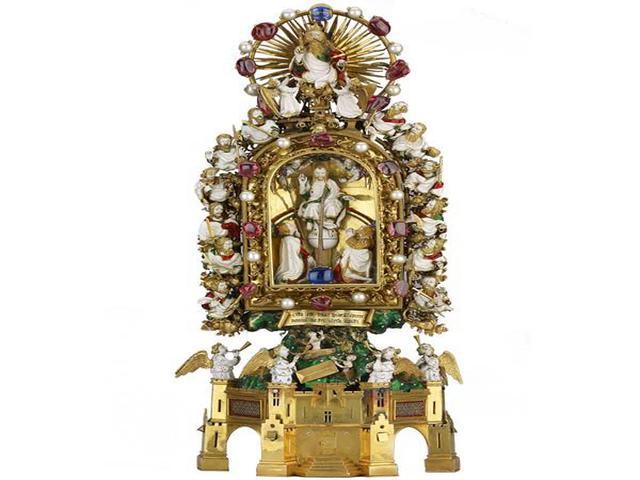The Holy Thron Reliquary

The Holy Thorn Reliquary is a stunning and intricate piece of medieval art that holds great significance in the history of Christianity. Crafted by Jean duc de Berry in the early 15th century, this reliquary was designed to house a single thorn believed to be from the crown worn by Jesus during his crucifixion. The relic was acquired by King Louis IX of France in 1239 AD for a staggering sum of 135,000 pounds, a substantial portion of the country's annual expenditure at the time. The reliquary itself is a masterpiece of craftsmanship, featuring a large sapphire at its center and adorned with a dramatic scene of the Last Judgment.
The scene depicted on the Holy Thorn Reliquary is rich in symbolism and religious imagery. Surrounding the relic are figures of the Virgin Mary, Saint John the Baptist, and Christ, with the twelve apostles and God the Father also represented. At the bottom of the reliquary, angels blow trumpets as the dead emerge from their graves, while a golden relief of the Holy Face on the cloth of Saint Veronica can be seen behind the figure of God. This intricate design serves as a visual representation of the Christian faith and the belief in the power of relics to connect believers with the divine.
During the medieval period, relics played a significant role in the religious life of Christians. They were believed to possess miraculous healing powers and were venerated as a means of connecting with saints and Christ himself. Pilgrims would travel great distances to visit shrines housing important relics, such as the Holy Thorn Reliquary, in hopes of receiving blessings and spiritual guidance. The trade in sacred relics was a lucrative business, with kings and nobles amassing large collections and even engaging in wars to acquire these precious artifacts.
The Holy Thorn Reliquary stands as a testament to the enduring power of faith and the importance of religious relics in medieval Europe. Its intricate design and rich symbolism continue to captivate viewers and serve as a reminder of the deep spiritual beliefs of the past. As a point of interest for tourists visiting London, this remarkable piece of art offers a glimpse into the religious practices and beliefs of the medieval period, inviting visitors to explore the intersection of faith, art, and history.
© ChatGPT 3.5